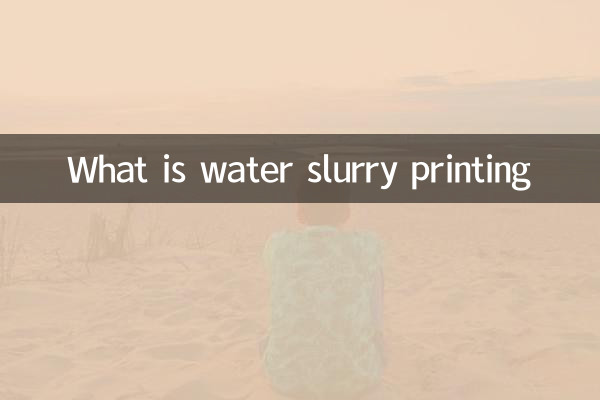What is water slurry printing
Water slurry printing is a common textile printing process, which has attracted widespread attention due to its environmental protection, low cost and wide application range. In recent years, with the increase in consumers' demand for environmentally friendly and personalized clothing, water slurry printing technology has once again become a hot topic. This article will introduce in detail the definition, characteristics, process flow and comparison with other printing technologies of water slurry printing to help readers fully understand this technology.
1. Definition of water slurry printing

Water slurry printing is a printing process with water-soluble slurry as the main medium, and the patterns are printed on fabrics through screen printing. Its characteristic is that the printing paste is highly fluid and is suitable for use on light-colored or white fabrics, which can present a delicate pattern effect.
2. Characteristics of water slurry printing
Water slurry printing has the following distinctive features:
| Features | describe |
|---|---|
| Environmental protection | The slurry used for water slurry printing uses water as a solvent, does not contain harmful substances such as heavy metals, and meets environmental protection standards. |
| Low cost | Water slurry printing equipment and materials are low in cost and are suitable for small and medium-sized mass production. |
| Good breathability | The fabric after printing has a soft feel and is not affected by breathability, making it suitable for summer clothing. |
| Wide applicability | Suitable for natural fiber fabrics such as cotton, linen, and viscose, but dark fabrics have poor results. |
3. Process flow of water slurry printing
The main processes of water slurry printing include:
| step | Specific operations |
|---|---|
| Pattern design | Design patterns according to customer needs and make color separation drafts. |
| Plate making | Screen printing plates are made through photosensitive plate making technology. |
| Adjust the slurry | Mix the water slurry with the color slurry in proportion to prepare the desired color. |
| printing | Screen-print the paste onto the fabric to ensure clear patterns. |
| Dry and solid color | The slurry is fixed to the fabric by high-temperature drying, thereby improving color fastness. |
| Post-processing | Clean excess slurry and carry out quality inspection and packaging. |
4. Comparison between water slurry printing and other printing technologies
Compared with water slurry printing and adhesive printing, digital printing and other processes, they have their advantages and disadvantages:
| Print type | advantage | shortcoming |
|---|---|---|
| Water slurry printing | Environmentally friendly, breathable, low cost | Not suitable for dark fabrics, low color saturation |
| Glue printing | Bright colors, suitable for dark fabrics | Harder feel and poor breathability |
| Digital printing | Fine pattern, customizable | High cost, suitable for small batch production |
5. Recent hot topics and industry trends
In the past 10 days, hot topics related to water slurry printing have mainly focused on environmental protection and personalized needs:
| topic | Popularity index |
|---|---|
| Environmentally friendly printing technology is sought after | ★★★★★ |
| Application of water slurry printing in trendy clothing | ★★★★☆ |
| Water slurry printing and sustainable fashion | ★★★★☆ |
| Research and development of new water slurry printing materials | ★★★☆☆ |
6. Summary
Water slurry printing occupies an important position in the textile industry due to its environmental protection, economical and comfortable characteristics. Despite limitations in dark fabrics and color expressiveness, water slurry printing will still be an important development direction for future printing technology with the advancement of technology and the growth of market demand. Consumers' pursuit of environmental protection and personalization will further promote the innovation and application of water slurry printing technology.

check the details

check the details